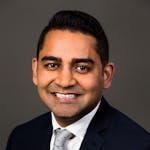How do we mobilize the financing we need to achieve the Sustainable Development Goals (SDGs)? This question is top of mind as members of government, civil society, and the private sector gather at the United Nations this week for the Forum on Financing for Development.
The forum is a moment to assess progress toward the Addis Ababa Action Agenda, an agreement reached by world leaders in 2015 to generate financing for the SDGs. And it takes place against a worrisome backdrop: Last week, the International Monetary Fund forecast a slowdown in global economic growth and the Organization for Economic Co-operation and Development reported a decline in global aid. Additionally, a United Nations task force released the “2019 Financing for Sustainable Development,” which called for an overhaul of the global financial system.
To better understand the UN report and what needs to happen to finance the SDGs, I talked to the UN Foundation’s Executive Director for Policy Minh-Thu Pham.
Jenni Lee: The UN’s “Financing for Sustainable Development” report is pretty blunt that we are not where we need to be in terms of financing for the Sustainable Development Goals. What are some of the biggest hurdles?
Minh-Thu Pham: There are many, but I want to mention five specifically.
First, one of the biggest hurdles is our global economic outlook. There are signs that the world may be looking at a peak in economic growth. I think people are concerned because the rates of growth that we’ve seen are not going to be maintained, much less increase.
Second, the trade debates that are playing out right now are also signs that we are going in the wrong direction. The report notes that, “More than half a trillion dollars’ worth of goods are subject to trade restrictions, seven times more than a year ago.”
Third, the issue of countries’ debt distress is huge. Debt risks are rising. There are about 30 Least Developed Countries that are at high levels of debt distress, and that’s going to really impact their ability to invest in the SDGs and in their own development. If there is only one thing we take away from this year’s report, it should be that debt distress is a huge issue for the countries where we need to make the most progress on the SDGs.
Fourth, inequality. Inequality within many countries has grown dramatically, and I think that’s a really worrying sign.
Finally, there is poor direct investment in, and capital flows to, the least developed countries. The signs are not positive there.
Estimates are that we’ll need anywhere from $5 trillion – $12 trillion a year to achieve the SDGs, and we’re clearly nowhere near that with Official Development Assistance (ODA). Countries will need to look at foreign direct investment and how to attract investors. And there, the signs are worrying, especially when you have an economic downturn globally.
JL: Does the report contain any good news?
MTP: Yes. Increasingly people are looking at the impact of their investments on the things they care about, like the environment and social issues. They want to make investments that are sustainable.
There is also a move toward making longer-term investments and taking longer-term perspectives.
Currently, companies report on a quarterly basis and governments are only in power two or four years, so there is tendency to focus on the short-term, which can have negative impacts in the long-term. So we need to invest for the long-term, make policies for the long-term, and think long-term. We’re not there yet, but there is some positive movement.
A great example is the World Benchmarking Alliance, which the UN Foundation helped launch. This is a really great effort in trying to get us to think about the impact of what companies are doing on the Sustainable Development Goals.
JL: The report makes the case that we need to change the financial system – what are its recommendations? What needs to change and how does that happen?
MTP: The fast pace of technological change and globalization has made people realize that the rules that we’ve been working under need to be changed and that we need to have a lot more voices at the table. We need to reinvigorate collective action.
So how do we work together? And how do we make sure that we’re not just including those who have money and are already at the table? We need to remake the rules so collective action works a lot better, and we are fit for purpose for sustainable development. That was a big message in this report. We want the global economic system to be fair and equitable, and not exacerbate the inequality we’re seeing.
JL: The report noted that alongside collective action, there needs to be national action. What were the key takeaways for governments and finance ministers?
MTP: Achieving the SDGs and delivering on the sustainable development agenda has to start at the national level. Each country has its own local context and level of development.
While countries have started to outline what they need to achieve the SDGs, many still haven’t outlined their financing plans to implement them.
The report makes a clear call that all countries need to develop integrated financing frameworks to support their national development strategies. It’s not enough to just come up with your development plan for getting to the SGDs; you have to figure out how to finance it. So there’s a big effort now to get countries to adopt integrated national financing frameworks to deliver on the SDGs.
JL: We know there needs to be a role for the private sector given the scope of the financing needs. What is the key message in the report for the private sector?
MTP: That the private sector needs to shift from prioritizing short-term gains to looking toward long-term investment horizons.
We need companies to examine how their goods and services impact the environment. And we need a system that incentivizes companies to invest in long-term strategies that are positive for people and the planet.
JL: We’ve discussed the roles of governments and the private sector. Now, let’s turn to the UN. What is its role in mobilizing financing for sustainable development?
MTP: The UN has three main roles for this. One is agenda setting – doing things like writing this report and identifying issues we need to focus on.
Second, the UN serves as a hub for different actors to come together and collaborate. Financing the SDGs is not only about governments; it’s also about the private sector coming in to help. The UN is a platform for those conversations. This is vital, because we need the public and private sectors to break out of their silos, so they work together and make the whole greater than the sums of its parts.
This week, the UN is hosting the Financing for Development forum, the annual moment for the UN and stakeholders who care about financing to come together and assess progress on the financing for development agenda. While governments are coming together to talk about finance, there will also be an SDG Investment Fair where investors and companies will come together to talk about how they can support specific projects that will support sustainable development in countries. For investors, this is about doing good and being able to get a return for your investment.
Lastly, the UN’s role includes setting norms. How should we think about acceptable behavior for companies, for citizens, and for sustainable development? The UN can help set the norm that long-term investments and long-term thinking are good for everybody, including good for the bottom line.
JL: What did I miss? What else is there to note about financing for sustainable development?
MTP: The climate agenda. In the past, people have separately talked about climate financing and financing for development. Now, I think the conversation is turning to, “How do we make sure that development is also environmentally sustainable?” The discussion is shifting to look at how we incentivize financing for development to be good for the environment too.
One other thing I’ll say is that we have a really exciting opportunity this September during the UN General Assembly’s high-level week. This year, we will have discussions at the heads of state level on the financing for development agenda, on how we tackle climate change, and on the SDGs. This is a chance for world leaders to think about those three issues and how to accelerate progress on them.




 View All Blog Posts
View All Blog Posts
